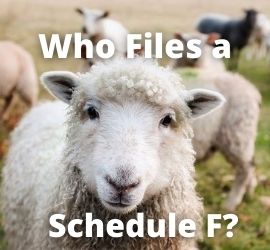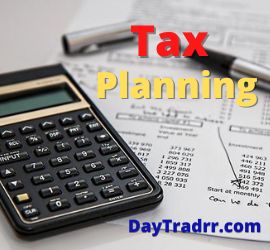What Is a Schedule F: Profit or Loss from Farming?
 Schedule F (Form 1040) is used by farmers who operate as sole proprietors to report their farming income and claim their expense deductions.
Schedule F (Form 1040) is used by farmers who operate as sole proprietors to report their farming income and claim their expense deductions.
If you are a farmer and your farming business is a sole proprietorship, you must use Schedule F. Schedule F attaches to a 1040 tax form to report your profit or loss from farming for the previous tax year. Farm income includes funds derived from enterprises operating in livestock, dairy, poultry, fish, fruit, or vegetables. It also includes income earned from a plantation, ranch, range, orchard, grove, or nursery specializing in ornamental plants.
Your farming profit or loss is listed on Schedule F and then transferred to a form 1040 for computing your total tax liability. Schedule F is to farmers what Schedule C is to other sole proprietors.
What Is Schedule F Used For?
Schedule F asks questions about your agricultural business as well as sources of revenue and expenses. For example:
Income
- Principal farming activity or crop
- Income from selling livestock, produce, grains, or other products;
- Other income – whether you received farm income from cooperative distributions, agricultural program payments, Commodity Credit Corporation loans, crop insurance proceeds, federal crop disaster payments, or any other sources.
Schedule F provides different ways to account for your income. For example, whether you use a cash basis or accrual accounting method.
Expenses
Who files a Schedule F?
- You Must Be a Farmer – Qualifying as a farmer doesn’t just mean that you grow crops. The definition of “farmer” used by the government includes ranchers, fish breeders, and homeowners who do things like keep chickens and earn income from selling their eggs. A farmer is anyone who pursues or receives income from cultivating crops and/or livestock, whether it’s on a farm, ranch, range, or in an orchard.
- Your Farm Is a Business – Farming as a business is differentiated from farming as a hobby for tax purposes. Only farmers who operate as businesses are required to file Schedule F. You must be engaged in farming for profit to be considered a business
- You’re a Sole Proprietor – Schedule F is only used by farmers who are considered to be sole proprietors. Those who operate their farming businesses through a corporation or other business entity would report their incomes and expenses on Form 1120 instead.
Schedule F – What can be Deducted?
Farmers, like other business owners, may deduct ordinary and necessary expenses paid in carrying on any trade or business. In agriculture, these ordinary and necessary expenses include car and truck expenses, fertilizer, seed, rent, insurance, fuel, and other costs of operating a farm. Schedule F itemizes many of these expenses. Following is a summary of several key expense deductions for farmers.
Car and Truck Expenses
Farmers, like other business owners, have the option to either (1) deduct the actual cost of operating a truck or car in their business or (2) deduct the standard mileage rate for each mile of business use.
- Actual Cost – Those taxpayers who choose the actual cost method may deduct those expenses related to the business use of the vehicle. These include gasoline, oil, repairs, license tags, insurance, and depreciation (subject to certain limits). Farmers choosing this method must keep good records of these expenses.
- Standard Mileage Rate – The standard mileage rate for 2019 is 58 cents per mile (57.5 cents in 2020). Taxpayers that operate five or more cars or light trucks at the same time are not eligible to use the standard mileage rate.
- Personal vs business use – When vehicles are used for both personal and business purposes, the taxpayer may take deductions only for the percentage of use attributable to the business. This requires detailed recordkeeping. Farmers, however, have a special rule under which they can claim 75% of the use of a car or light truck as business use without any allocation records. The rule applies if the taxpayer used the vehicle during most of the normal business day directly in connection with the business of farming. A farmer chooses this method of substantiating business use the first year the vehicle is placed in service. Once that choice is made, it cannot be changed.
Wages and repairs
Farmers can deduct the reasonable wages paid for workers hired to assist in the farming operations. Also deductible is employee benefits paid to those workers. Many farmers can deduct wages paid to family members, as long as the wages are reasonable and a true employer-employee relationship exists. One fairly complicated category of deductible expenses is that for repairs and maintenance. Generally, farmers may deduct the cost of repairing and maintaining farm property. This includes, for example, the cost of replacing shingles on farm buildings or routine maintenance of farm machinery. Improvements designed to prolong the life of the business property, however, must be capitalized, not deducted.
Conservation
Active farmers may be able to presently deduct the cost of conservation practices implemented as part of an NRCS-approved or comparable state-approved plan. Farmers can select the soil and water conservation deduction which is taken in the year the improvements are made. This is for conservation expenditures in an amount of up to 25 percent of the farmer’s gross income from farming. The deduction can only be taken for improvements made on land used for farming. Excess amounts may be carried forward to future tax years.
Once the farmer makes this expense election, it is the only method available to claim soil and conservation expenses. If the farmer stops farming or dies before the full cost has been deducted, any unused deduction is lost. It cannot then be capitalized to reduce any gain upon the sale of the farm. Landowners who are not eligible for the deduction must capitalize the expenses and add them to the basis of the property.
Other normal expenses
Other common expenses farmers may usually deduct include interest paid on farm mortgages, certain breeding fees, the cost of fertilizer or lime if the benefits last a year or less, real estate and personal property taxes, business insurance, rental payments (for property used in the farm business), depreciation, truck, and car expenses, veterinary expenses, and business use of the home.
Farmers, like other taxpayers, can deduct business-related fees paid to accountants, bookkeepers, and attorneys, fees for educational expenses designed to improve farming skills, and the costs of subscriptions to farming publications. Those in the business of farming may also deduct many soil and water conservation expenses. However, the amount of this deduction cannot exceed 25 percent of the amount of gross income received from farming. (Source: extension.iastate.edu)
Schedule F – Other Income and Payments
Farm Income
In U.S. agricultural policy, farm income can be divided as follows:
- Gross Cash Income: the sum of all receipts from the sale of crops, livestock, and farm-related goods and services, as well as any direct payments from the government.
- Gross Farm Income: the same as gross cash income with the addition of non-money income, such as the value of home consumption of self-produced food.
- Net Cash Income: the gross cash income less all cash expenses, such as for feed, seed, fertilizer, property taxes, interest on debt, wagers, contract labor, and rent to non-operator landlords.
- Net Farm Income: the gross farm income minus cash expenses and non-cash expenses, such as capital consumption and farm household expenses.
Payments Made to Third Parties
Schedule F also asks if you made any payments during the tax year that required you to file Form 1099 and if you have filed it. An example of a case where you would need to file Form 1099 is if you hired an independent contractor to perform more than $600 worth of work. This would include transporting your produce to a weekly farmer’s market, for your farm business.
Schedule F – Additional Resources
For more information:
- IRS Publication 225 – the Farmer’s Tax Guide, is a document that helps individuals involved in agribusiness navigate the farming-specific tax code. The document details and outlines how the federal government taxes farms. Individuals will be liable for taxes if the farm is operated for profit, whether the taxpayer owns the farm or is a tenant. IRS Publication 225 outlines the different accounting methods that farmers may use for running their operations and how farmers must report farm income.
- IRS Publication 51 – is a document specific to the employers of agricultural workers. Publication 51 guides how individuals who employ workers in agribusiness must comply with tax withholdings. Sometimes the U.S. Department of Labor requires employers to register with them. Also, it does not allow employers to label farm employees as independent contractors.
Up Next: What is Net Change?
 Net change refers to the difference in the closing price of a stock, bond, or other traded financial instrument from one period to the next.
Net change refers to the difference in the closing price of a stock, bond, or other traded financial instrument from one period to the next.
In general, the net change is the difference between a previous value and its current value. In the stock market, it most commonly refers to the prior trading period’s closing price and the current trading period’s closing price for a given security. For stock prices, the net change usually refers to a daily time frame. Therefore, the net change can be positive or negative for the given day in question. The change for stocks and most securities are quoted in U.S. Dollars when reported by financial media. However, the change can be calculated and quoted in any denomination depending on what is being traded and reported.
In other words, the net change is the difference between the closing price of a prior trading period and the closing price of the current trading period for a financial security. The measure is generally used for stock prices, bond prices, mutual funds, derivative products, and other tradeable securities. It usually refers to the daily change in price and represents the most common data represented for financial quotes. All trading platforms and real-time market data providers show net change when quoting prices. It is also an important information source for technical analysis. The change can be positive or negative. Therefore, it represents whether the markets are up or down from the previous day.




